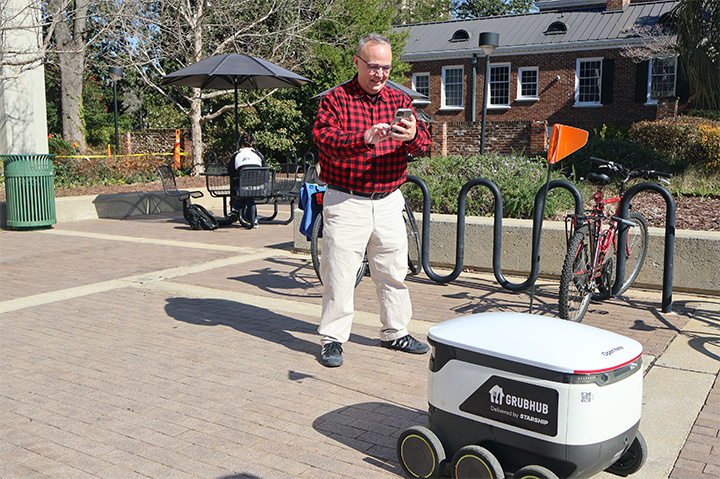Brandon Sondstarm, an employee at USC’s Russell House student union, places a Grubhub order into a food delivery robot. (Photos by Emelia Ribero/Carolina News and Reporter)
The new food delivery robots on USC’s campus have been followed by stares everywhere they go since their debut last week.
Based on student feedback, it’s apparent that controversy surrounds the robots. Some students think they’re convenient, but others have pointed out downsides such as an extra delivery fee and long wait times. Regardless, everyone is taking notice, sharing countless videos and jokes about them.
“I want to bully this robot so bad,” student Andres Gonzalez said. “It’s so small, I could just like kick it over. I’m not going to do that because he’s very nice.”
USC announced Feb. 5 that the partnership with Starship Technologies, Grubhub and Aramark, that the robot delivery service is in its trial stage. But the robots are hard at work in an attempt to lessen demand on 11 commercial dining facilities that serve students.
The robots – equipped with voice prompts and a visual map of the USC campus – were brought on to help shorten wait times and high demand for food, especially at Russell House, the university’s student union. The building has been the subject of much controversy after the university proposed a plan recently for a new student union to accommodate USC’s growing student body.
The robots’ arrival will be a big adjustment for students, but they’ll soon become part of the natural landscape, President Michael Amiridis said.
USC is the next university to join a long line of others who have pioneered the partnership since 2022.
Many find the 1-foot-tall robots cute, while others joke about their vulnerability.
They have been known to turn left and right before choosing a direction to drive and for waiting longer than necessary to safely cross the street, mimicking human uncertainty.
Students also have reported the robots asking them to press the walk button for them to ensure their safety.
Amiridis said fraternity members at another university threw one of the robots there into a river. And USC students have been resharing a video of one being hit by a train at Oregon University.
A poll posted on Instagram by @southcarolinachicks, an affiliate of Barstool Sports followed by more than 54,000 members of the USC community, asked students whether they love or hate the new bots. After two days, 55% of more than 1,000 responders said they love the bots. And 45% said they aren’t a fan.
Some USC students feel the robots are not an effective solution to cut down wait times and high demand at Russell House.
Several haven’t used the service because of the 30-40 minute wait time, and others are turned off by the added $3.50 delivery fee, which goes to the sponsoring company, Aramark.
“There’s no point in me waiting 40 minutes and then paying like $4 when I can just walk in here,” student Alex Jackson said.
Some students say the service is a good option for students who are sick or want to stay in their dorms. But student Kathryn Roth said she wouldn’t spend the extra money.
Students have the option of using off-campus food delivery services such as Doordash or Uber Eats. But the Grubhub service allows them to pay for food using their university meal plan and gives them access to order from on-campus dining facilities.
The project is still in its trial stage, so the robots can’t reach everywhere on the 360-acre campus.
Students Collin Cochcroft and Kaitlyn Decarlis, residents of Blossom Street’s East Quad and Green Quad respectively, have to wait for the project to be expanded before they can benefit from the service, The robots cannot yet cross major roads like Blossom, which runs directly through campus.
Because students and faculty are fascinated with the new robots, orders have been in high demand. But the question the university seeks to answer is whether the robots will be an effective long-term solution.
Many students feel that the convenience would be worth the wait on rainy or busy days. The robots are built to withstand weather conditions such as heavy rain and wind.
The dining hall at the new Campus Village dorms closes at 7:30 p.m. or 8 p.m., depending on the day, making later dining options less convenient.
“When I’m really busy, I don’t want to be going to get food,” resident Paul Strickler said. “When I can’t go somewhere and I’m really crunched on time doing schoolwork, it is pretty clutch to be like, ‘Oh, I can order my food and then it will come.’ I would say it’s a little pricey.”
Plans are in the works to expand the project with a possible 60 robots. Both Amiridis and Strickler said they would like to see food delivery via drones in the future.




